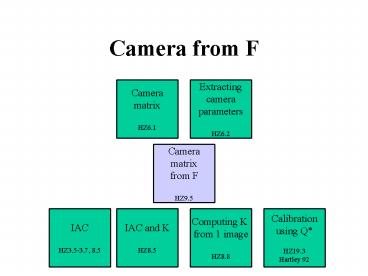Camera from F PowerPoint PPT Presentation
1 / 6
Title: Camera from F
1
Camera from F
Extracting camera parameters HZ6.2
Camera matrix HZ6.1
Camera matrix from F HZ9.5
Computing K from 1 image HZ8.8
IAC and K HZ8.5
IAC HZ3.5-3.7, 8.5
Calibration using Q HZ19.3 Hartley 92
2
F does not uniquely identify a camera pair
- a fundamental matrix F relates two images, and
therefore two cameras - F already gives indirect information about the
camera through the epipole (the null vector of F) - we will now see that much fuller information
about both cameras can be extracted from F, in
particular the two camera matrices - but a fundamental matrix does not uniquely
identify two camera matrices - Theorem Let H be a homography of 3-space. The
fundamental matrix associated with camera pair
(P,P) is the same as the fundamental matrix
associated with camera pair (PH, PH). - Proof if (x PX, x PX) is a point
correspondence in the 1st camera system arising
from 3d point X, then (x (PH)(H-1X), x
(PH)(H-1X)) is a point correspondence in the 2nd
camera system arising from 3d point H-1X - thus, upon finding F, we only know the camera
matrix up to a homography - analogous to affine rectification extra work is
required to remove this projective freedom and
get to metric structure of the camera (stay
tuned!) - luckily this is the only degree of freedom if
two camera pairs have the same F, then they must
differ by a homography (Thm 9.10) - HZ254
3
F does not depend on world frame
- camera matrix depends on image frame and world
frame, since x PX is dependent on the image
coordinates x and the world coordinates X - but the above result is telling us that the
fundamental matrix is independent of the world
frame - we are happy to relax to within a similarity of
the truth, but we are relaxing to within a
projectivity of the truth, which pleases us less - we will need calibration techniques
- (these calibration techniques may be interpreted
as ways of protecting the absolute conic) - HZ253
4
Camera matrix from F
- lets see what we can get from F
- we assume that the first camera matrix is always
I 0 - we can always normalize so that it is, using some
homography - we are solving for the relative offset of the
2nd camera from the 1st - Lemma F is fundamental matrix of camera pair
(P,P) iff PtFP is skew-symmetric. - Proof PtFP is skew-symmetric ?? Xt (PtFP) X
0 for all X ?? xt F x 0 where x PX and x
PX, the images of X ?? F is fundamental matrix of
(P,P) - Theorem The camera matrices associated with F
may be chosen to be I 0 and SF e where - et F 0 (2nd image epipole)
- S any skew-symmetric matrix
- proof just check that SF et F I 0 is
skew-symmetric - Corollary The camera matrices associated with F
may be chosen to be I 0 and ex F e. - choose S ex to guarantee a rank 3 camera
matrix P - see proof on 256
- ironic to guarantee rank 3 P (necessary, so
good), we force rank 2 M (a bit bad) - HZ255-6
5
Pseudoinverse P
- the camera matrix P is rectangular (3x4) so it
does not have an inverse - but we want to use the notion of inverse to talk
about the preimage of an image point - a rectangular matrix P has a pseudoinverse P
- P (Pt P)-1 Pt
- note that Pt P is square
- note that P degenerates to P-1 when P is square
and nonsingular - x Ab is the least-squares solution of Axb if
A is full rank (Trefethen 81)
6
F from P
- two camera matrices do uniquely specify a
fundamental matrix - let P and P be two camera matrices, and e the
epipole in the 2nd image - note e can be calculated as PC (image of other
camera center) - the associated fundamental matrix of these 2
cameras - F ex P P
- note PP is the homography H in the earlier
definition of F ex H - proof idea epipolar line of x is built from the
epipole e and the camera-2-image of a typical
point of the camera-1-preimage of x (or P Px) - proof Fx L e x P (P x) so F ex P
P - note how the fundamental and camera matrices are
independent of the actual contents of the image
only dependent on the camera setup - HZ244

